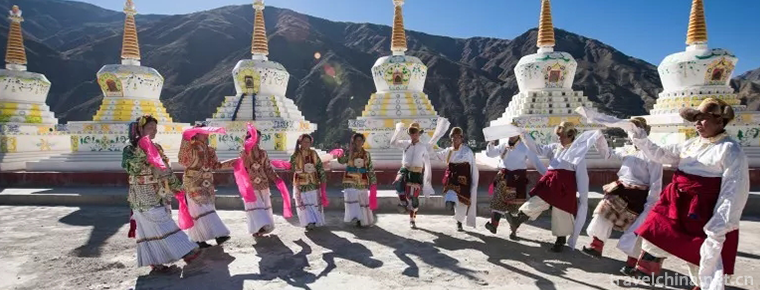De rong xue qiang
De rong xue qiang
Derong Xueqiang is a folk dance popular in Waka Township, Derong County, Ganzi Prefecture. Its movements are strong, simple and generous, its next steps are strong and its feet are crisp. When the dancers bend down and change their steps, their movements appear flexible and free and easy. The combination of stamping and pedaling creates a unique charm of Qiang dance.
On June 7, 2008, the "Derong Xueqiang" declared by Derong County of Sichuan Province was listed in the second batch of national intangible cultural heritage list with the approval of the State Council.
Heritage serial number: 663 III-66.
historical origin
Xueqiang, also known as "love dance", is a unique form of folk song and dance created by the ancestors of Waka on the basis of combining Tibetan and Naxi folk arts. According to the folk legend of Derong, Princess Wencheng of Tang Dynasty (Princess Naxi) came to Tibet by way of this place. In order to welcome the princess, Derong Tusi Geng Awu specially gathered local folk artists to create songs and dances that could make the princess understand and have local characteristics. Eventually, Qiang songs and dances, which integrated the styles of Han, Tibetan, Naxi and Bai nationalities, came into being.
Because of the remote location and inconvenient transportation, these folk art treasures have been hidden deep in the mountains. Through the help of Tibetan cadres and participation in the Festival of Non-Heritage, the Derong Cultural Heritage will come out of the mountains.
artistic characteristics
Xueqiang means dancing together. It is popular in Waka Town (Atomic Geng Township) of Derong County. It is also a kind of folk entertainment singing and dancing that the local people are most willing to participate in. The Qiang dance style and music color are unique, which is different from Ganzi Tibetan dance charm.
The movements are characterized by the bouncing and jumping of legs, and the lyrics are mostly about the love between young men and women. Nanlu Guozhuang is primitive, elegant and dignified. When performing, men and women circle around each other and sing and dance in turns. When dancing, they hold hands with each other or hold waist, bend down with low head, dance posture, upper body movements are small, and the main movements are concentrated on the foot and leg.
Inheritance status
As a kind of folk dance, Xueqiang is closely related to the folk activities of the people. Every festival, gathering and village where men and women, old and young, gather together, jump up to learn Qiang to show harmony and auspiciousness. Especially on autumn harvest night, people light bonfires, gather around them, and add the game of "jumping fire". It can be seen that the dance form of learning Qiang is also connected with the people's play and play.
Inheritance significance
The dance originated from the folk and spread to the folk. It has strong local characteristics in terms of lyrics, rhymes and steps. It contains the spiritual beliefs and value orientations handed down from generation to generation by the people who have won the honor, and has unique humanistic significance.


-
1.sauteed tofu in hot and spicy sauce
sauteed tofu in hot and spicy sauce is one of the traditional dishes in Sichuan
Time 2018-10-12 -
2.Bassoon ba song cuo
Basongtao, also known as Caogao Lake, means "green water" in Tibetan. It is about 18 kilometers long. Its surface area is about 27 square kilometers.
Time 2019-01-02 -
3.suyukou national forest park
Suyukou National Forest Park is located in Helan Mountain National Nature Reserve, 50 kilometers northwest of Yinchuan City, capital of Ningxia. It is a national 4A-level tourist attraction.
Time 2019-02-13 -
4.Sebin Festival of Ewenki Nationality
"Serbin" is an Ewenki language, meaning "happy and peaceful". Sebin Festival is a traditional festival of the Ewenki people. On Sebin Festival, Ewenki hunters gather together
Time 2019-04-28 -
5.Kite making skills
Kite making skills, Weifang City of Shandong Province, Nantong City of Jiangsu Province, Lhasa City of Tibet Autonomous Region, Beijing, Tianjin and other local traditional skills, one of the national
Time 2019-04-29 -
6.Boxwood carving
Boxwood carving is one of the traditional folk carving arts in Zhejiang Province. It uses boxwood as carving material and uses the natural form of boxwood, which is smooth, delicate in texture and sol
Time 2019-05-04 -
7.Beijing embroidery
Beijing embroidery, also known as palace embroidery, is an ancient Chinese traditional embroidery technology, the general name of embroidery products centered on Beijing. Ming and Qing
Time 2019-05-07 -
8.Gongs and drums
The Gong and drum books used to be called "Taibaoshu", "Taibao" is derived from the activities of "Taibu" in the countryside of Shanghai suburbs and counties, which seeks
Time 2019-05-15 -
9.Miaos Rock planting Custom
Traditionally, the Miao people have a kind of public deliberation and legislative activities called "burying rock" (also known as "planting rock". When burying rock, they bury a re
Time 2019-06-05 -
10.Stone Appreciation Art
In the form of both pictures and texts, Stone Appreciation Art popularizes the knowledge of Stone Appreciation Art to readers, especially young readers.
Time 2019-06-13 -
11.Guangyuan tertiary industry
In 2018, the total social fixed asset investment in Guangyuan was 67.221 billion yuan, an increase of 14.1% in the same caliber. Among them, investment in fixed assets was 64.721 billion yuan, an increase of 16.4%.
Time 2020-12-15 -
12.History of Nanchong
In the Northern Song Dynasty (960-1127), there were three states in the territory, which governed 13 counties, such as Nanchong (prefecture), Xichong and Xiangru, which were subordinate to Chengdu Fulu.
Time 2020-12-17